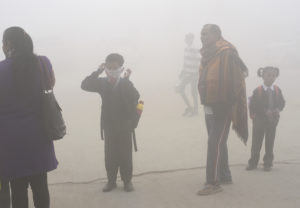New Delhi has been covered in smog for days now, forcing residents to stay inside, shutting down schools and closing businesses. Traffic has slowed as accidents have increased due to the poor visibility. The city is reportedly suffering from pollution 10 times worse than Beijing, China–and that place is known for its poor air quality. India has historically had the most air pollution related deaths, with China close behind. In New Delhi, people who have the money have been purchasing air filters for their homes.

Pollution caused 9 million “premature deaths” in 2015, according to “The Lancet Commission on pollution and health,” a report from 19 October, 2017. It is estimated to be responsible for 16% of deaths worldwide and “three times more deaths from AIDS, tuberculosis, and malaria combined and 15 times more than all wars and other forms of violence. In the most severely affected countries, pollution-related disease is responsible for more than one death in four.” The journal “Nature” reported that in 2007, 3.25 million deaths were due to air pollution alone. There are other types of pollution, such as the pollution of goods and services or water.
How does pollution kill you? It depends on the type–let’s take the obvious one, air pollution. Particulate matter 2.5 (PM 2.5) is a small, nasty mixture of gasoline or coal byproducts. It’s incredibly small (2.5 microns), and drifts into your lungs and then into your circulatory system–the highway to the rest of your body. If you have ever been in a city completely overrun with pollution–and I’m not talking about an average day in NYC–you realize that this is not a joke. I spent five years in Chiang Mai, Thailand, and largely due to the slash-and-burn style farming nearby (though some would blame it on government-backed industrial operations), the pollution would funnel into the city turning it into some kind of dystopian looking place for a couple of months. Soon after, it would dissipate and go back to its normal, sunny self.
One obvious difficulty is that these problems can’t necessarily be solved locally, if the pollution is unintentionally produced elsewhere and drifts into neighboring areas. This is especially difficult when you’re talking about international borders. Health issues aside, no one is going to be happy if massive clouds of smog are drifting into their city because of the actions of another, nearby country.
Though this is an environmental concern regarding our effect on nature, it is not to be confused with the controversial issue of global warming or climate change. Pollution is a direct contamination of the air that you breathe or the water that you drink, whereas global warming discusses the implications of permanent and long-term damages due to the rising temperature and how our carbon pollution affects that. You can see how the issues overlap and could possibly directly affect one another, but they are still separate terms nonetheless.

Featured image courtesy of AP Images.










COMMENTS
You must become a subscriber or login to view or post comments on this article.